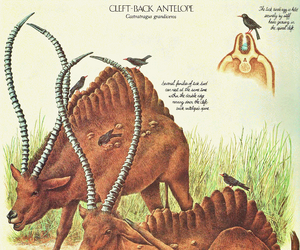
The cleft-back antelope is a relict of the past. It is one of the few surviving basic-looking members of the large number of non-gigantelope/non-hornhead antelope species that were once found throughout the Quaternary.
The cleft-back antelope, Castratragus grandiceros, is a reduncine bovid from the tropical grasslands of Lemuria that is superficially similar to an ancestral antelope.
It has a curious symbiotic relationship with the tick bird. This relationship is really no more than a strengthening of the symbiosis that had developed between small birds and large grazing mammals during the early part of the Cenozoic. Birds on the grassy plains often accompanied the large mammals, catching the insects disturbed by their hooves, or pecking ticks and mites from the hides of the big mammals themselves. The grazing mammals tolerated this as the little birds rid them of parasites and also gave warning of approaching danger. In the case of the cleft-back antelope the relationship has become more intimate and the animal's back has ceased to be a mere perch and has become a nesting site. Along the animal's back is a pair of ridges, supported by outgrowths from the vetebrae. Between the ridges is a deep cleft lined by stiff hairs that provide an ideal nesting medium for the tick bird. Several families may nest on its back at one time. Superficial warts on the animal's flanks produce pus at certain times of the year. The pus attracts flies, which lay eggs in the warts. The flies' maggots appear just as the young birds are hatching and provide them with a readymade source of food. In return the antelope is supplied with both a constant grooming service and an early warning system that alerts it to approaching predators.

Cleft-backs are ruminants. They have four-chambered stomachs through which their food passes to extract its maximum nutritional content.
